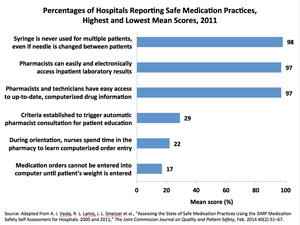Synopsis
U.S. hospitals have made great strides over the past decade in instituting practices to improve medication safety, according to results of the most recent Medication Safety Self Assessment. Low scores in some areas—such as mandating certain kinds of information-collection and educating staff—point to priorities for action.
The Issue
The 1999 Institute of Medicine report, To Err Is Human, shed light on the widespread problem of harmful medication errors in U.S. hospitals. In 2000, the Institute for Safe Medication Practices developed and fielded the Medication Safety Self Assessment to give hospitals a tool with which to gauge the safety of their medication practices and identify opportunities for improvement. In 2011, an updated assessment tool was sent to 5,786 hospitals to determine if they had made progress; 1,310 completed the survey. Commonwealth Fund–supported researchers compared the results, explored progress in improving medication safety, and analyzed how hospitals’ characteristics affected their scores.
Key Findings
- Overall, the total mean score of respondents increased significantly from 2000 to 2011, from 56 percent to 71 percent—a 27 percent improvement.
- Hospitals reported the greatest improvement in the following areas:
- Communication of drug orders and other drug information improved by 57 percent. For example, use of computerized prescriber order entry (CPOE) increased from 6 percent to 55 percent.
- Patient education increased from 48 percent to 68 percent. For example, 73 percent of hospitals reported they provide customized drug administration schedules to patients at high risk for nonadherence at discharge—up from 31 percent in 2000.
- Quality processes and risk management increased from 51 percent to 72 percent. Improvements were seen in safety culture, detection, reporting, and analyzing errors.
- The lowest scores in 2011 were in areas related to patient information, staff competency and education, and drug information.
- In 2011, hospitals with a medication safety officer scored higher on all key elements than hospitals without one.
Addressing the Problem

Based on the survey results, the researchers suggested the following priorities to further improve medication safety: improve order entry systems; expand key technologies; better manage alert fatigue; update and test technology more frequently; use data more consistently to improve safety; improve care of patients receiving opioids; standardize pediatric postoperative solutions; use metric system only; expand outpatient and inpatient services; increase patient education; more thoroughly orient staff; teach risk identification/prevention strategies; increase leaders’ support for safety and error reporting; measure medication safety more effectively; and be more proactive about medication safety.
About the Study
All U.S. hospitals were asked to complete the 2011 Medication Safety Self Assessment, which included 270 items organized into 10 key elements and 20 core characteristics. Each item had five possible responses, ranging from no activity, some discussion, partial implementation, full implementation in some areas, and full implementation throughout the facility. For the 2011 survey, 1,310 of the 5,786 U.S. hospitals submitted data, a response rate of 23 percent—the same as in 2000.
THE BOTTOM LINE
The survey found evidence of substantial improvements in medication safety over the past decade, though there is still room for improvement in several areas. Local, state, and national policies are needed to catalyze action.


